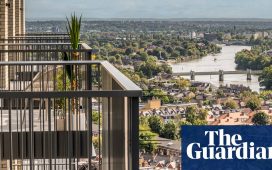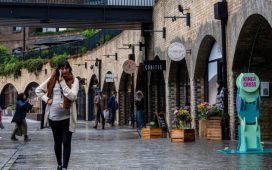Unlock the Editor’s Digest for free
Roula Khalaf, Editor of the FT, selects her favourite stories in this weekly newsletter.
Several of the UK’s biggest housebuilders welcomed Sir Keir Starmer’s pledge to develop new towns and make it easier to build homes on brownfield sites should he win the next UK general election.
The Labour leader set out the plan as part of his vision for a decade of “national renewal” in his speech to the party conference in Liverpool on Tuesday.
He promised to target areas with good transport links and significant housing shortages, in an echo of the party’s rebuilding programme after the second world war.
“Sometimes the old Labour ideas are right for new times. So where there are good jobs, where there is good infrastructure, where there is good land for affordable homes, then we will get shovels in the ground,” Starmer told a packed conference hall. “Getting Britain building again is critical for economic growth, our most important mission.”
Starmer also set out plans to allow housebuilders to build in some parts of the greenbelt, such as “dreary wasteland” which he said should be renamed the “grey belt”.
Labour officials gave few further details beyond pledging to develop a “handful” of new towns with green spaces and attractive high streets. They promised “nature spots or important green spaces” would be protected.
The announcement was welcomed by major UK housebuilders including Berkeley Group, Barratt Developments, Persimmon Homes, Taylor Wimpey and Vistry Group as well as investment group Legal & General.
“The proposals combine short-term actions and medium-term strategy which will knit together a system that is currently dysfunctional,” said Mark Skilbeck, planning director at Taylor Wimpey. “We believe that these reforms should lead to speedier decisions across the country and ultimately much-needed homes.”
Sir Nigel Wilson, chief executive of L&G, said that meeting the UK’s housing needs required “national and local collaboration coupled with modernisation of planning and construction, improvements to funding and a change in culture”. Labour’s approach took “a holistic view of these barriers to deliver ambitious outcomes,” he added.
Labour has previously set out plans to build 1.5mn homes over five years, equivalent to 300,000 homes a year, though it said it would not be able to meet that annual level immediately.
It has promised to reinstate compulsory local housebuilding targets, pointing out that new home completions were set to drop to 160,000 per year by the time of the election.
Under Starmer’s plan, local leaders would bid for sites in their areas to be selected, and the government would set up corporations to take on planning in those regions and make compulsory purchases of land where necessary.
Housing developers would be awarded “planning passports” which would make it easier for them to build on brownfield sites. First-time buyers would be given “first dibs” on newly built homes, according to Labour officials.
The move to relax roadblocks to housebuilding fits into a wider drive by the Labour party to work with the private sector to drive economic growth and regional regeneration without increasing taxation or state funding.
Marc Vlessing, chief executive of Pocket Living, a smaller developer, said Starmer’s “pro-builder speech” had contrasted “rather sharply” with that of Labour’s deputy leader Angela Rayner earlier in the week, which he said “did rather demonise the builders”.
Rayner told delegates the party would “strengthen the rules to prevent developers from wriggling out of their responsibilities and . . . speed up the building of new social and affordable housing”. She also signalled that local leaders would get powers “to stand up to vested interests in building new developments”.
Vlessing said he would await the details of Starmer’s pledge. “You don’t reform planning with headline-grabbing slogans,” he added.
The new towns policy by the Labour government in the immediate aftermath of the second world war was aimed at relieving pressures on housing in major cities, which had suffered extensive bomb damage. The first developments included Stevenage in Hertfordshire and Crawley in Sussex.










